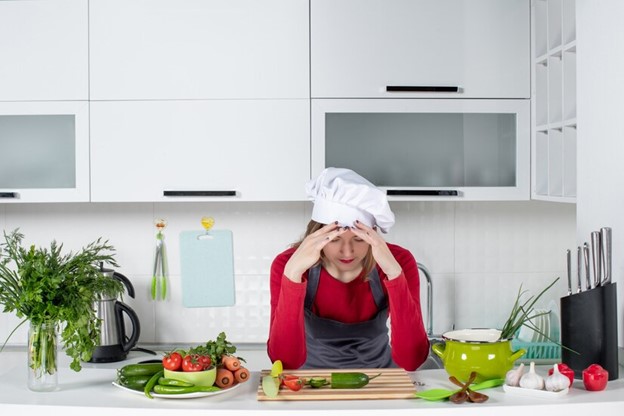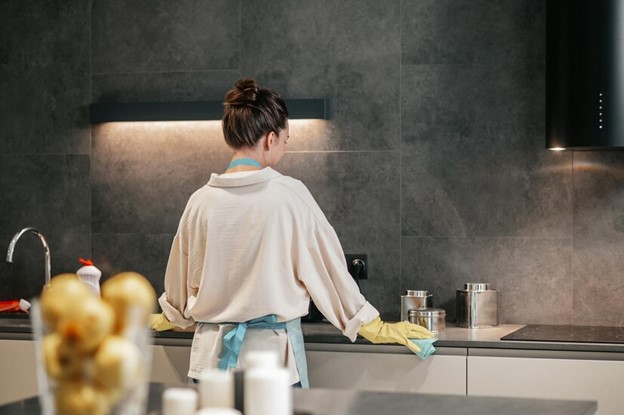Why Your Kitchen is a Bacteria Breeding Ground – Watch Out!
While it's easy to overlook, maintaining a clean and bacteria-free kitchen is essential for your family's health.
In this article, we'll explore the hidden dangers lurking in your kitchen, pinpoint the bacterial hotspots, delve into how these microorganisms thrive, and discuss effective ways to keep your kitchen spick and span. Let's dive right in.
Is Your Kitchen Making You Sick?

Before we delve into the nitty-gritty details of kitchen hygiene and bacterial hotspots, let's discuss the potential hazards of an unclean kitchen. Your kitchen may be harboring harmful microorganisms that could put your health at risk.
Here are some of the common problems associated with an unsanitary kitchen:
- Foodborne illnesses: Bacteria like Salmonella, E. coli, and Listeria can contaminate your food, leading to food poisoning. These pathogens can cause symptoms ranging from stomach cramps and diarrhea to more severe conditions that may require hospitalization.
- Cross-contamination: Improper handling of raw meats, vegetables, and other food items can lead to cross-contamination. This occurs when bacteria from one food item spread to another, increasing the risk of foodborne illnesses.
- Mold and Fungi: Neglected kitchen surfaces can become breeding grounds for mold and fungi. These microorganisms release spores that can cause respiratory issues and allergies, especially in individuals with pre-existing conditions.
- Pest infestations: Leftover food particles and dirty dishes attract pests like cockroaches and rodents. These pests can carry diseases and contaminate your kitchen, posing a significant health risk.
Now that we understand the potential dangers of an unclean kitchen, let's uncover the specific bacterial hotspots in your culinary domain.
Bacterial Hotspots in Your Kitchen

If you want to maintain a hygienic kitchen environment, you must first identify the areas that are most likely to serve as breeding grounds for harmful microorganisms.
The following kitchen items are most likely to become hotbeds of bacteria:
Kitchen Sponge
Surprisingly, your kitchen sponge is one of the dirtiest items in your home. Its damp, porous surface is the perfect breeding ground for bacteria. The warm, moist environment allows bacteria to multiply rapidly, making your sponge a potential source of contamination.
To combat this, regularly disinfect your sponge by microwaving it on high for one minute or running it through a dishwasher cycle. You can also replace your sponge regularly to reduce the risk of bacterial buildup.
Cutting Boards
Cutting boards, especially those used for raw meats, can harbor dangerous bacteria. The crevices in the board's surface can trap food particles, providing an ideal environment for pathogens to thrive.
It is a good idea to use separate cutting boards for raw meats and other food items. After use, wash the cutting boards with hot, soapy water and disinfect them with a disinfectant kitchen cleaner. Wooden cutting boards may require more maintenance than plastic ones, as they can absorb moisture and bacteria.
Refrigerator Drawers
The crisper drawers in your refrigerator can accumulate moisture and food residue, creating a haven for bacteria and mold growth. Regularly clean and sanitize these drawers to prevent contamination of your fresh produce.
Sink and Drain
Your kitchen sink, including the drain, is another common bacterial hotspot. Food particles often accumulate in the sink, providing nutrients for bacteria. The drain can also be home to biofilm, a slimy substance that harbors harmful microorganisms.
To maintain proper kitchen hygiene, clean your sink and drain daily. Regularly disinfect the sink and surrounding areas with a kitchen cleaner.
Dishcloths and Towels
Dishcloths and kitchen towels are used for various tasks, from wiping countertops to drying dishes. However, they can quickly become contaminated with bacteria, especially if not changed or laundered frequently.
To combat this, change dishcloths and kitchen towels regularly and wash them in hot water with bleach to kill bacteria. Consider using disposable paper towels for certain tasks to reduce the risk of contamination.
Countertops
Countertops, which come into contact with all sorts of ingredients and food items, are susceptible to bacterial contamination. Cracks and crevices can trap food particles and moisture, providing a breeding ground for pathogens.
To maintain a clean and hygienic kitchen, clean countertops daily with a disinfectant kitchen cleaner. Pay special attention to seams and edges, as these areas can hide debris. Additionally, avoid placing bags, purses, or other potentially contaminated items on your kitchen counters.
Can Opener
Your can opener may seem innocuous, but it can accumulate food residue and bacteria if not properly cleaned. After opening canned goods, take a moment to wash and disinfect the can opener blade to prevent bacterial buildup.
Effective Kitchen Hygiene Tips for Combatting Bacteria

Now that you're aware of the potential bacterial hotspots in your kitchen, let's explore some essential kitchen hygiene tips to keep your culinary space clean and safe:
- Hand washing: Proper hand washing is the first line of defense against foodborne illnesses. Always wash your hands with soap and warm water for at least 20 seconds before handling food, especially after touching raw meat, poultry, or seafood.
- Cross-contamination prevention: To avoid cross-contamination, use separate cutting boards and utensils for raw meats and other foods. Clean and disinfect these items thoroughly after use.
- Refrigeration: Keep your refrigerator temperature at or below 40°F (4°C) to slow down bacterial growth. Store raw meat, poultry, and seafood on the lowest shelf to prevent their juices from dripping onto other foods.
- Proper storage of leftovers: When storing leftovers, use airtight containers to prevent bacterial contamination. Consume or freeze leftovers within a reasonable timeframe to avoid foodborne illnesses.
- Maintaining the right cooking temperatures: Ensure that your food reaches the recommended internal temperature to kill harmful bacteria. Use a food thermometer to check the temperature of meats and poultry.
- Following a regular cleaning routine: Establish a regular cleaning routine in your kitchen. Clean and disinfect kitchen surfaces, utensils, and appliances after each use, and do a deep clean at least once a week.
Don't Let Your Kitchen Compromise Your Wellbeing
To sum it up, your kitchen can be a bacterial breeding ground if you don't maintain it properly. The potential hazards of an unsanitary kitchen include foodborne illnesses, cross-contamination, mold and fungi growth, and pest infestations. To combat these issues, identify and tackle bacterial hotspots like the kitchen sponge, cutting boards, refrigerator drawers, the sink and drain, dishcloths and towels, countertops, and can openers.
By following kitchen hygiene tips, such as proper hand washing, preventing cross-contamination, refrigerating food correctly, storing leftovers safely, cooking to the right temperatures, and establishing a regular cleaning routine, you can significantly reduce the risk of your kitchen making you sick.
Maintaining a clean and hygienic kitchen is not only about aesthetics but also about safeguarding your health and the health of your loved ones. So, roll up your sleeves, grab your disinfectant kitchen cleaner, and embark on a journey toward a hygienic, more sanitary kitchen.
Your culinary creations will not only taste better but also be cleaner. Your kitchen may have been a bacterium breeding ground, but with the right knowledge and practices, you can transform it into a safe haven for food preparation.
